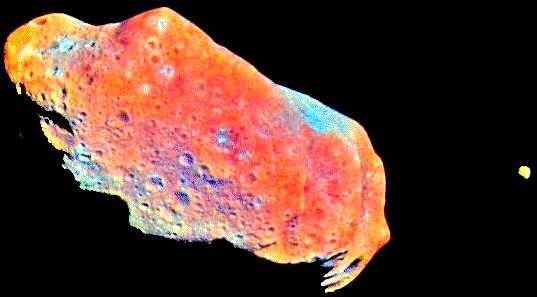
L'ASTEROIDE IDA E IL SUO SATELLITE DACTYL 
Douglas Isbell, James H. Wilson
Il satellite dell'asteroide, scoperto dalla sonda Galileo, ha un nome.
L'Unione Astronomica Internazionale (I.A.U.) ha approvato la proposta di chiamare Dactyl la piccolissima Luna, scoperta quest'anno dalla missione Galileo della N.A.S.A., in orbita intorno all'asteroide Ida.
The IAU also approved names for surface features on
another asteroid, Gaspra, which became the first asteroid
ever visited by a spacecraft when Galileo flew by it on Oct.
29, 1991.
Dactyl č il primo satellite naturale di un asteroide scoperto e fotografato. Questa piccola Luna, distante circa 1,5 km, č apparsa nelle immagini trasmesse da Galileo nell'agosto del 1993, durante il suo volo vicino all'asteroide.

Dactyl was discovered in data analyzed in March 1994 by
members of Galileo's imaging and infrared science teams. The
project recommended the name to the IAU, which is responsible
by international agreement for the formal naming of Solar
System bodies.
The name is derived from the Dactyli, a group of
mythological beings who lived on Mount Ida, where the infant
Zeus was hidden -- and raised, in some accounts -- by the
nymph Ida and protected by the Dactyli. Other mythological
accounts say that the Dactyli were Ida's children by Zeus.
Three regions on Gaspra were named for scientists
associated with the asteroid. Neujmin Regio was named for G.
Neujmin, the Ukrainian astronomer who discovered the asteroid
in 1916. Yeates Regio honors the late
Dr. Clayne M. Yeates, who was Galileo Science Manager and
Science and Mission Design Manager until his death in 1991.
Dunne Regio was named in honor of the late Dr. James A.
Dunne, who served as Galileo Science and Mission Design
Manager until late 1992.
"Clayne Yeates and Jim Dunne both contributed immensely to
the Galileo project and to the Gaspra encounter in
particular," said Galileo Project Manager William J. O'Neil
at NASA's Jet Propulsion Laboratory (JPL), Pasadena, Calif.
The surfaces of Gaspra and Ida are covered with impact
craters like those on Earth's Moon. Gaspra was named by
Neujmin for a resort on the Crimean peninsula. Consequently,
many of the asteroid's craters have been named for resorts
and spas worldwide.
The Galileo spacecraft is on its way to Jupiter, where it LA SONDA GALILEOč SULLA STRADA PER RAGGIUNGERE GIOVE
will send a probe into the atmosphere on Dec. 7, 1995, and
then go into orbit for a two-year scientific tour of the
planet, its satellites and its magnetosphere. JPL manages
the Galileo project for NASA's Office of Space Science,
Washington, D.C.